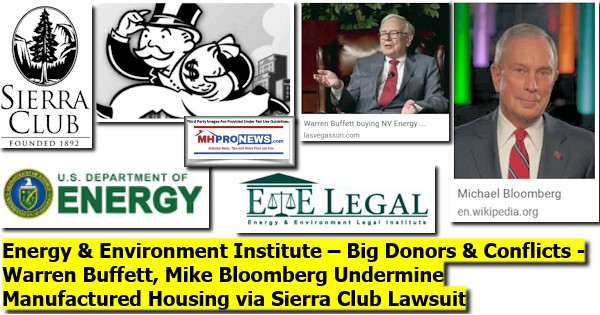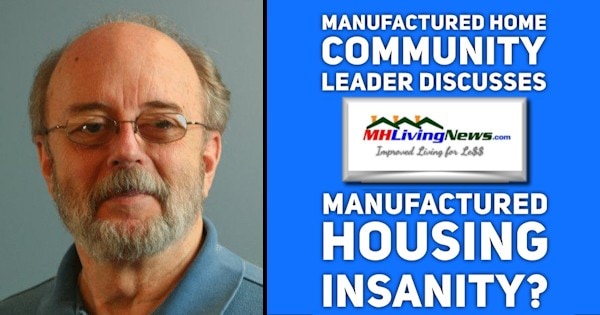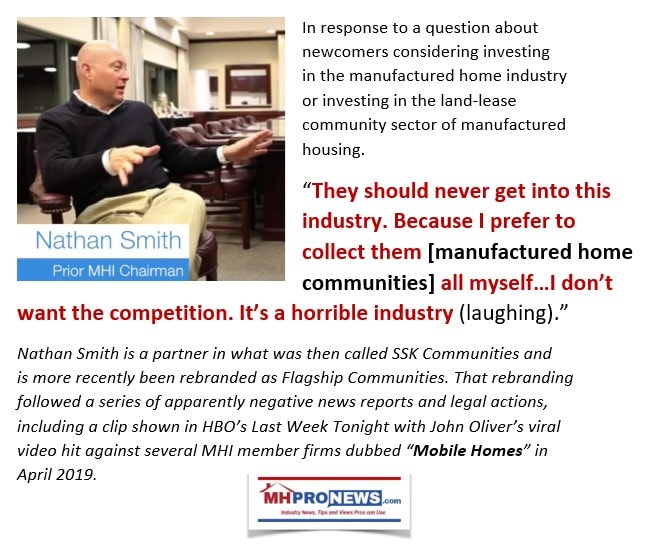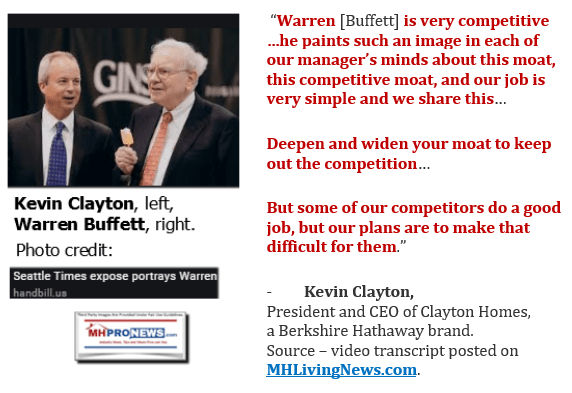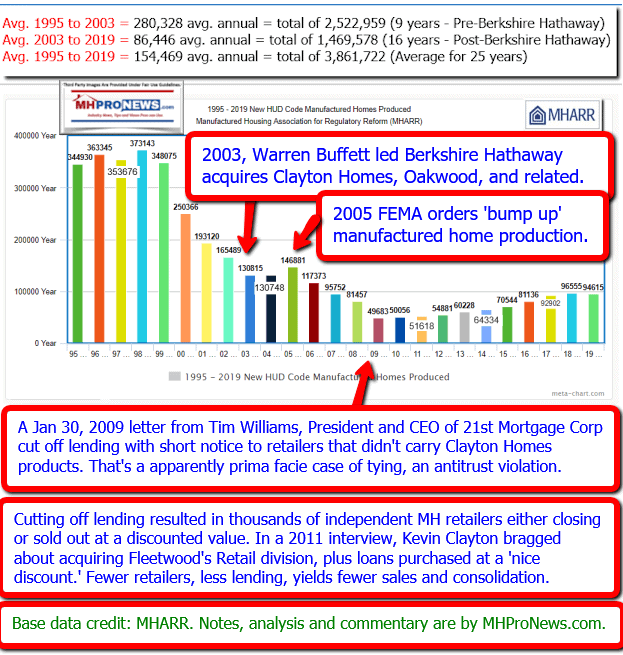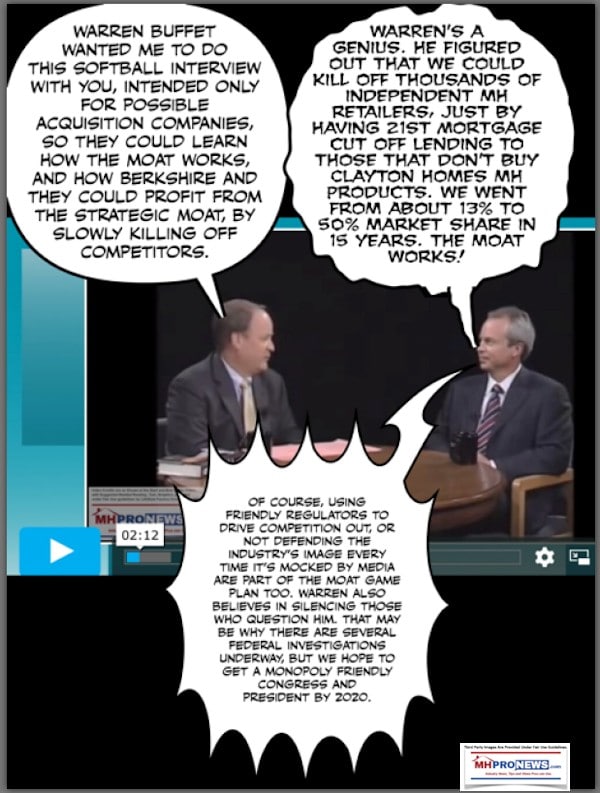“First things first. We get through the pandemic, then we turn on one another and start assigning blame.
Alternatively, since we’re already doing what we can on the former, we start drawing lessons now…” –
John Robson –
Grotesque Failure:
Preferring Communist China Over Democratic US, in Epoch Times.
“Get your facts first, then you can distort them as you please.”
– Mark Twain per BrainyQuote.
“Pay more attention to what people are doing than what they are saying. Or,
never mind what people are saying, watch what they are doing.”
– Marty Lavin,
in a previous comment to MHProNews.
Writing about Samuel Clemens, who wrote for a newspaper in Virginia City, Nevada using the pen name Mark Twain, the Economic Times said in 2016 said that, “The consummate storyteller that he [Twain] was, many of his stories were vivid and gripping while actually being clever and fantastic fabrications. And he was unapologetic about it and would never let truth stand in the way of a good story.
However, as the stories got more and more outrageous, his hoaxes began involving local public figures, women’s groups and even the rival newspaper, Virginia Daily Union. He was known to say, “Get your facts first, then you can distort them as you please.””
Hold that thought of Twain as an entertaining liar as some are still willing to weave yarns that are spin or outright fabrications. Propaganda and paltering are far from new. The current pandemic is a tragic crisis that has a potential silver lining, but only if a significant part of society strives at avoiding a return to the status quo ante.
This calamity is an apt time to assess how our Republic got into this sad spot in time. Not some spin or ‘gotcha’ talking points, but the true underlying realities that allowed our nation and so many others to become vulnerable to potentially mortal risks to health, economics, and political alignments – in this instance from a serious contagion.
This is also a grim opportunity for manufactured housing professionals to ponder: why has manufactured housing been underperforming for over 15 years?
This report will be a juxtaposition of Smith’s own statements vs. the latest federal filings by the Manufactured Housing Association for Regulatory Reform (MHARR). But in doing so it is first worth mentioning a bold statement made by Ken Cashin President of Windstorm Holdings, while he was chairman of MHI. At a Manufactured Housing Institute (MHI) business meeting during the time that Ken Cashin of Windstrom Holdings was the organization’s chairman, Cashin stated to dozens of attendees in the room that “We all know who” the “elephant in the room is.” Cashin said that “elephant in the room” was Danny Ghorbani, who was then president and CEO of the MHARR. Ghorbani still serves as an advisor to MHARR.
Former Manufactured Housing Institute Vice President Sounds Off on Manufactured Home Financing
Cashin’s was an ironic, eye-brow raising comment. Hold that assertion by former MHI chairman Cashin in mind, as it will be part of the analysis further below.
For industry newcomers or researchers, it bears mention that MHI alternatively claims itself to represent ‘all segments of factory-built housing’ or alternatively, representing “all segments of manufactured housing.” By contrast, MHARR more modestly asserts that it represents the views of the independent builders of smaller to medium sized HUD Code manufactured housing production. MHI claims a broad mandate while MHARR is laser-focused.
Nathan Smith in the transcript below says that the industry – often verbal shorthand or code-words for MHI – had to be honest with itself. He said the industry had failed to be pro-active, and he pledged during his term to change that reactive pattern.
Specifically, Smith said “This industry has not always been, umm, forthright with itself….in governmental affairs [lobbying, advocacy] you need to be pro-active not reactive. Because you want to find it [the threat or challenge] before it happens and not to have to deal with it [the threat or challenge] after it happens.…One of the things I, during my tenure as the chairman at MHI, I want to leave this organization with a pro-active government affairs [approach] not a reactive [one].”
Looking back, it is a fair question to ask, how has MHI done in the light of the standard that their prior chairman himself set for the Arlington based trade group?
Smith also said laughed as he said during that video interview that those considering investing in manufactured housing “They should never get into this industry. Because I prefer to collect them [manufactured home communities] all myself…I don’t want the competition. It’s a horrible industry.”
Ouch.
What’s troubling to numbers of manufactured housing industry professionals is that during an affordable housing crisis manufactured housing has been underperforming. That was true before this COVID19 pandemic. But how is that possible given the good laws that the industry had on the federal law books?
What follows is from MHARR in an item that will reportedly be published by them tomorrow. It is a copy of their regulatory comments to HUD’s Office of General Counsel regarding “Manufactured Home Construction and Safety Standards Proposed Rule – Docket No. FR-6149-P-01 – RIN 2502-AJ49.”
This gets technical and is cross-referenced, both of which are arguably valuable. The thrust of the comments are that HUD has for years failed to follow the letter of the Manufactured Housing Improvement Act (MHIA) of 2000, which they sometimes call the 2000 reform law. That regulatory overreach – which is the focus of what follows – drives up costs unnecessarily for producers, which means that consumers ultimately have to pay a higher cost than would otherwise occur in the absence of regulations that were imposed without proper prior authorization by the Manufactured Housing Consensus Committee (MHCC).
It is an issue that MHI addresses too. But quite to the contrary of what Smith said MHI should be doing, for years they have been in various cases advocating for more regulations, instead of fighting against it. An example is linked below.
Manufactured Housing Institute (MHI) Shifts on DOE Regulatory Rule, Report, Analysis
Put differently, MHI has purportedly not lived up to the prudent assertion that Smith made that the industry had failed on the regulatory front and had done so for years. It should be noted that Smith’s use of the phrase “the industry” is often in MHI circles a type of code-words for MHI itself.
With that foundation, let’s turn to MHARR’s comments. Following that this report will then pivot to an MHProNews analysis and commentary.
March 30, 2020
VIA FEDERAL EXPRESS AND ELECTRONIC SUBMISSION
Regulations Division
Office of General Counsel
U.S. Department of Housing and Urban Development
451 7th Street, S.W.
Room 10276
Washington, D.C. 20410-0500
Re: Manufactured Home Construction and Safety Standards
Proposed Rule – Docket No. FR-6149-P-01 – RIN 2502-AJ49
Dear Sir or Madam:
The following comments are submitted on behalf of the Manufactured Housing Association for Regulatory Reform (MHARR). MHARR is a Washington, D.C.-based national trade association representing the views and interests of producers of manufactured housing regulated by the U.S. Department of Housing and Urban Development (HUD) pursuant to the National Manufactured Housing Construction and Safety Standards Act of 1974 (42 U.S.C. 5401, et seq.) (1974 Act) as amended by the Manufactured Housing Improvement Act of 2000 (2000 reform law). MHARR was founded in 1985. Its members include smaller and medium-sized independent manufactured housing businesses from all regions of the United States.[1]
- INTRODUCTION
On January 31, 2020, HUD published a Notice of Proposed Rulemaking (NOPR) in the Federal Register[2] seeking public comment on various modifications to the Federal Manufactured Housing Construction and Safety Standards (24 C.F.R 3280, et seq.) (FMHCSS/Standards) recommended by the Manufactured Housing Consensus Committee (MHCC) in accordance with section 604 of the Manufactured Housing Improvement Act of 2000 (42 U.S.C. 5401, 5403). While MHARR generally supports the amendments recommended by the MHCC and proposed by HUD (some of which have been pending since 2006), it nevertheless questions HUD’s rationale for the inclusion of certain matters — but not others (that are more relevant to the mainstream HUD Code manufactured housing market) — in the proposed rule, and the potential impact of those decisions on the competitiveness of the HUD Code manufactured housing market (see, section II B, below) particularly in light of production levels over the past decade-plus, which have fallen significantly below historic industry norms. In addition, as presented in greater detail below, MHARR hereby reiterates its longstanding and consistent call for the retraction of specific sub-regulatory HUD “guidance” memoranda related to proposed standards and regulations set forth in the January 31, 2020 NOPR and, more importantly, the withdrawal of all extant federal program “guidance” documents in accordance with President Trump’s Executive Order (EO) 13891 (“Promoting the Rule of Law Through Improved Agency Guidance Documents”)(October 9, 2019) and Office of Management and Budget (OMB) Memorandum M-20-02 (October 31, 2019). HUD’s failure to do so, in violation of President Trump’s directives, not only continues, unnecessarily, extremely costly pseudo-regulatory burdens that disproportionately impact smaller industry businesses[3] (to the benefit of the largest industry conglomerates), but also needlessly and prejudicially increase the purchase price paid by consumers for HUD-regulated manufactured homes.
- COMMENTS
- REQUIREMENTS FOR ATTACHED GARAGES AND CARPORTS
The January 31, 2020 NOPR sets forth a number of new standards and Procedural and Enforcement Regulations (PER) relating to manufactured homes designed to accommodate either factory or site-constructed garages and carports.[4] The proposed standards and regulations would effectively obviate previous sub-regulatory[5] HUD “guidance” memoranda which mandated the approval of attached garage and “add-on”-ready manufactured homes via the “Alternative Construction” (AC) process set forth at 24 C.F.R. 3282.14.[6] While HUD, on May 20, 2019,[7] formally rescinded separate 2017 departmental “guidance” specifically regarding the AC treatment of carports and carport-ready manufactured homes pursuant to 24 C.F.R. 3282.7(b), its rescission document specifically left in place — and in effect — 2014 “guidance” memoranda requiring AC approval for manufactured homes with (or designed to accommodate) attached garages.
Although HUD’s action to remove the issue of attached garages and carports from the costly Alternative Construction process[8] is a positive step,[9] it nevertheless begs the question with respect to at least three related and critically-important regulatory policy issues that are not addressed by the NOPR and have not been explained or otherwise rectified by HUD’s Office of Manufactured Housing Programs (OMHP). These include: (1) specific recognition – and repudiation of – OMHP’s past unlawful utilization of unpublished, sub-regulatory “guidance” to subject attached garages and carports to the “costly and burdensome” AC process ab initio; (2) specific recognition – and repudiation of – OMHP’s unlawful pattern and practice of utilizing unpublished sub-regulatory “guidance” documents more broadly to enact other de facto mandates in violation of relevant, mandatory statutory procedures; and (3) recognition and clarification of HUD’s failure, to date, to take further action, pursuant to Executive Orders 13891[10] and 13892 (“Promoting the Rule of Law Through Transparency and Fairness in Civil Administrative Enforcement and Adjudication”)[11] to withdraw or otherwise invalidate all other outstanding OMHP sub-regulatory “guidance” documents as well. Absent the express and expeditious resolution of each of these matters, OMHP continues to operate in defiance of President Trump’s regulatory policies.
- HUD SHOULD SPECIFICALLY REPUDIATE THE USE
OF “GUIDANCE” DOCUMENTS TO ESTABLISH
DE-FACTO MANUFACTURED HOUSING “STANDARDS”
The 2000 reform law establishes mandatory procedures for the adoption of new manufactured housing standards, PER regulations, Interpretive Bulletins and other similar requirements of general applicability.[12] Those procedures include both mandatory MHCC review and notice and comment rulemaking in accordance with section 604 of the 2000 reform law and section 553 of the Administrative Procedure Act (APA)(5 U.S.C. 553). HUD, in the past, however – and in this case — has circumvented these statutory procedural requirements by utilizing sub-regulatory “guidance” or “field guidance” memoranda, adopted unilaterally, with no public process whatsoever, in order to impose new or modified de facto mandates on regulated parties. HUD’s prior directives in this matter (issued by former OMHP administrator Pamela Danner) — providing that attached garages and carports must be designed and approved in accordance with the 3282.14 alternative construction process, a new requirement involving significant additional costs for regulated manufacturers, as conceded by HUD itself[13]— were issued with no prior MHCC review and no prior notice and comment rulemaking, in direct violation of the procedural and consensus requirements of the 2000 reform law, but with no acknowledgment of that fact by HUD in either its NOPR or any other public forum.
MHARR, at the time such “guidance” was issued — and incident to the similar abuse of “guidance” documents by OMHP[14]— strongly objected to HUD’s unlawful utilization of so-called “guidance” documents to circumvent the procedural requirements of the 2000 reform law. OMHP, however, under its former Administrator, Pamela Danner, summarily rejected not only these objections, but also a December 2014 request and recommendation by the statutory MHCC for HUD to “immediately consider suspending action and enforcement of its June 12, 2014 [attached garage] memorandum.”[15]
MHARR specifically renewed its procedural objections to the abuse of such “guidance” in April 25, 2018 correspondence to Acting HUD General Assistant Secretary Dana Wade, referencing November 16, 2017 and January 25, 2018 U.S. Department of Justice (DOJ) memoranda, stating that DOJ would not take court action to enforce regulatory mandates imposed by Executive Branch agencies without notice and comment as required by law. MHARR’s correspondence stated, in relevant part: “[A]s is demonstrated by the November 16, 2017 and January 25, 2018 memoranda, the Justice Department would quite properly refuse to enforce any such “guidance” documents issued without rulemaking and prior MHCC review … in any enforcement proceeding sought by HUD…. Accordingly, rather than leaving those unenforceable ‘guidance’ documents on the public record, with their inevitable – albeit unlawful – ‘in terrorem’[16] effect on regulated parties (and corresponding additional regulatory compliance costs needlessly imposed on consumers and manufacturers), those ‘guidance’ documents … should be declared null and void … and formally withdrawn.” (Emphasis in original).
Even more recently, MHARR’s position with respect to sub-regulatory HUD “guidance” – including but not limited to HUD “guidance” regarding attached carports and garages, was reaffirmed and reiterated by Trump Administration Executive Orders 13891 and 13892. EO 13891 thus provides, in relevant part: “Agencies may clarify existing obligations through non-binding guidance documents…. Yet agencies have sometimes used this authority inappropriately in attempts to regulate the public without following the rulemaking procedures of the [Administrative Procedure Act]. *** Americans deserve an open and fair regulatory process that imposes new obligations on the public only when consistent with applicable law and after an agency follows appropriate procedures. Therefore, it is the policy of the Executive Branch … to require that agencies treat guidance documents as non-binding both in law and in practice…. Agencies may impose legally binding requirements on the public only through regulations … and only after appropriate process….” (Emphasis added). EO 13892 further states: “Guidance documents may not be used to impose new standards of conduct …. The agency may not treat noncompliance with a standard of conduct announced solely in a guidance document as itself a violation of applicable statutes or regulations. (Emphasis added).
The policy enunciated in EOs 13891 and 13892 proves and reiterates that the 2000 reform law means what it says regarding the necessity of prior MHCC review and notice and comment rulemaking (i.e., the “appropriate procedures” referenced in the EOs) for all HUD actions specified in sections 604(a) (i.e., standards) and 604(b) (i.e., enforcement regulations, Interpretive Bulletins and changes to policies, procedures and practices affecting the standards, enforcement and monitoring).[17] This means that all HUD manufactured housing program “guidance” documents and similar “operating procedures” adopted since the effective date of the 2000 reform law without: (1) MHCC review and recommendation; and (2) notice and comment rulemaking as expressly required by the 2000 reform law are “non-binding” and unenforceable in violation of both Administration policy and underlying law. This includes, but is not limited to, all of HUD’s sub-regulatory “guidance” documents with respect to the AC treatment of attached carports and attached garages, and homes designed to accommodate either (or both) features.
And, while this conclusion is the unavoidable and necessary consequence of the application of section 604 of the 2000 reform law, section 553 of the Administrative Procedure Act, the 2017 and 2018 DOJ memoranda previously referenced by MHARR, and EOs 13891 and 13892, the complete invalidity of those “guidance” memoranda and documents is nowhere acknowledged, referenced or accepted by HUD/OMHP. Accordingly, HUD, as part of the instant docket and any final rule in this matter, should, at a minimum, specifically withdraw and repudiate each and every so-called “guidance” document issued in connection with attached garages and/or carports, so that there remains no lingering doubt or questions regarding any possible continued applicability of those unlawful pronouncements.
- HUD SHOULD WITHDRAW OR INVALIDATE ALL OF ITS
PREVIOUS SUB-REGULATORY “GUIDANCE” DOCUMENTS
In addition to the specific withdrawal and repudiation of its past sub-regulatory “guidance” pronouncements with respect to attached garages and carports, HUD should similarly – and on the same grounds and basis — rescind all of its outstanding manufactured housing “guidance” documents in accordance with EO 13891, to the extent that such “guidance” documents enunciate alleged requirements that either exceed or are inconsistent with existing statutory and/or regulatory authority and, contrary to the regulatory reform policies of President Trump, continue to impose disproportionate regulatory burdens and costs on smaller industry businesses while they unnecessarily increase the bottom-line cost for mainstream HUD Code housing paid by American consumers. This rescission should include, but is not limited to:
- Repeal of all elements of HUD’s program of expanded Subpart I in-plant regulation;
- Repeal of HUD’s February 2010 HUD “Interpretive Rule” regarding matters subject to MHCC review pursuant to section 604(b)(6) of the 2000 reform law;
- Withdrawal of all outstanding HUD “guidance” regarding the scope of federal preemption under the 1974 Act as amended, including HUD’s post-2000 reform law “guidance” on “Recent Program Activity;”
- Withdrawal of HUD’s still-pending “frost-free” guidance and proposed Interpretive Bulletin;
- Withdrawal of other “field guidance” and similar documents issued without MHCC consideration or notice and comment rulemaking, including, but not limited to:
- HUD’s Frost-Free Guidance memorandum;
- HUD’s Field Guidance and related Operating Procedures and memoranda concerning expanded in-plant regulation;
- Field Guidance on attic insulation;
- Field Guidance on air ducts;
- HUD Memorandum on “single-family” use;
- HUD Memorandum on electrical connection workmanship;
- HUD Memorandum on mixing valves;
- HUD Memorandum of deviation reports;
- HUD Memorandum on chassis bonding connections;
- HUD Memorandum regarding off-line fabrication;
- HUD Memorandum regarding on-site completion;
- HUD
- Memorandum on professional engineer/registered architect seals for wind zone II and III structural designs[18]
Based on EOs 13891 and 13892 (as well as EOs 13771 and 13777), HUD should: (1) withdraw or retract all sub-regulatory “guidance” documents and pronouncements issued by OMHP without prior MHCC review and notice and comment rulemaking; (2) in connection therewith, publish unequivocal notice in the Federal Register announcing the withdrawal and invalidation of those documents and advising regulated parties that they are no longer binding or operative in any respect; and (3) issue a further public directive stating that no further such documents shall be issued by OMHP without prior MHCC review and notice and comment rulemaking, and that any such documents issued without prior MHCC review and notice and comment rulemaking are null, void, and of no effect, ab initio, in accordance with section 604(b)(6) of the 2000 reform law.
- REQUIREMENTS FOR MULTI-STORY AND ATTACHED HOMES
While MHARR does not object, per se, to HUD’s proposal to adopt FMHCSS standards for multi-story manufactured homes[19] and “attached” manufactured homes,[20] legitimate questions can – and have been raised by stakeholders — regarding the basis for HUD’s apparent action to expedite those proposed standards, while MHCC-recommended standards for multi-family manufactured homes are not included in the instant NOPR and have yet to be proposed for adoption. Indeed, in the complete absence of any type of explanation in the NOPR of the obvious prioritization of the included standards for multi-story and “zero-lot-line” attached manufactured homes, as contrasted with broader proposed standards for multi-unit/multi-family manufactured homes, MHARR can only presume that HUD is acting to assist Fannie Mae and Freddie Mac to distort and effectively “hijack” the “Duty to Serve Underserved Markets” (DTS) provision of the Housing and Economic Recovery Act of 2008, so as to favor higher-end “new classes” of more costly manufactured homes produced by the industry’s largest corporate conglomerates, as contrasted with mainstream, affordable HUD Code manufactured homes, all at the expense of smaller industry producers and American consumers of affordable housing.
More specifically, why are the proposed multi-story and “zero-lo[t]-line” home standards – which date back to at least 2006 — being prioritized and proposed now, when much broader and potentially much more economically-significant and beneficial multi-unit/multi-family standards recommended by the MHCC are not included — and are virtually ignored by HUD — in its January 31, 2020 NOPR? There is no indication in the NOPR (or anywhere else) that such multi-story and “zero-lot-line” standards, for example, are a necessary predicate or pre-condition for the adoption of the multi-unit/multi-family standards recommended much more recently by the MHCC. Rather, the proposed multi-story and “zero-lot-line” proposals appear to have been resurrected “out of the blue” for the ultimate benefit of the industry’s largest corporate conglomerates which seek to construct larger, more costly, “new” types of manufactured housing to gain favored treatment under DTS from Fannie Mae and Freddie Mac which continue to totally avoid the 80% of the affordable manufactured housing market served by mainstream, traditional manufactured homes financed through personal property loans. Thus, instead of promoting affordable manufactured housing for all Americans as required by law, HUD appears to be abusing its regulatory authority to support Fannie Mae and Freddie Mac in order to benefit a narrow segment of the industry, while smaller manufacturers are kept waiting endlessly for proposed multi-unit/multi-family standards.
The fundamental issue of multi-family manufactured housing under the HUD Code was raised by yet another de facto “guidance” memorandum issued on October 3, 2014, former OMHP administrator Pamela Danner. That “guidance,” issued without prior MHCC review or notice and comment proceedings, ruled that “[M]anufacturers may not design or build manufactured homes labelled pursuant to the [FMHCSS] for multifamily or other non-single family residential use” and that “any manufactured home built under the federal program and bearing a HUD Certification Label may not be sold for purposes other than Single Family Use.”[21]This directive, purportedly, was based on section 3280.2 of the FMHCSS and section 3282.8(l) of the PER standards. MHARR, however, immediately objected, on the grounds that the 1974 Act (as amended) does not limit HUD Code manufactured housing to “one-family” or “single-family” use, and that HUD Code producers, retailers and communities should not be exposed to potential litigation or fines based on what does – or does not – constitute a “single-family.” Thus, MHARR emphasized, there was no statutory basis whatsoever for the single-family limitation contained in the 3280 standards and 3282 PER regulations. The MHCC, at its December 2014 meeting, agreed with MHARR’s concerns and subsequently began a process to develop and recommend to HUD, FMHCSS standards for “multi-unit,” multi-family manufactured homes, which it ultimately did.
While HUD’s January 31, 2002 NOPR does make an obtuse reference to “future” MHCC recommendations “for multi-family manufactured homes”[22]and indicates a concern for “parity” between HUD Code manufactured homes and “site-built housing,”[23]it does not address standards for multi-unit/multi-family manufactured homes and gives no indication when or even if multi-unit/multi-family manufactured homes will ever be addressed through the promulgation of new standards that are clearly and uncontrovertibly within the scope of present federal law. HUD, therefore, instead of concentrating on the elimination of unlawful sub-regulatory “guidance” under Trump Administration Executive Orders 13891 and 13892, and eliminating needless, costly, and needlessly burdensome regulatory mandates under Trump Administration Executive Orders 13771 and 13777, is instead, through its proposed action, creating more chaos and confusion, not only in the regulatory arena, but the manufactured housing consumer financing market as well.
Instead of correcting past regulatory missteps, then, HUD, through various aspects of this NOPR, appears to be abetting Fannie Mae and Freddie Mac in an ongoing effort to divert and distort DTS by shifting DTS support away from mainstream, affordable HUD Code manufactured housing, and toward, larger, more elaborate and much less affordable homes that are more like the site-built homes that both of the finance entities would rather deal with.
Rather than acting as an agent of the industry’s largest corporate conglomerates, HUD should fulfill its statutory duty to American consumers of affordable housing by including MHCC-recommended standards for multi-unit/multi-family manufactured homes in any final rule under the present docket.
- CONCLUSION
For all of the foregoing reasons, MHARR asks that HUD undertake the specific actions set forth herein, consistent with the policies enunciated by President Trump in Executive Orders 13771, 13777, 13891 and 13892.
Sincerely,
Mark Weiss
President & CEO
cc: Hon. Mike Pence
Hon. Brian Montgomery
Hon. Russell Vought (OMB)
Hon. Robert Compton
[1]All MHARR members are “small businesses” as defined by the U.S. Small Business Administration (SBA) and are “small entities” for purposes of the Regulatory Flexibility Act (5 U.S.C. 601, et seq.).
[2] See, 85 Federal Register No. 85, January 31, 2020 at p. 5589, et seq.
[3] See, e.g., Nicole V. Crain and W. Mark Crain, “The Impact of Regulatory Costs on Small Firms,” U.S. Small Business Administration, Office of Advocacy (2010).
[4] These include proposed modifications to 24 C.F.R. 3282.2, 3280.5, 3280.212 and 3280.213. See, 85 Federal Register, supra at p. 5590, col. 2, pp. 5591-5592 and pp. 5599-5602.
[5] I.e., supposed mandates on regulated parties, neither presented to nor recommended by the MHCC prior to adoption and implementation, or subjected to prior notice and comment rulemaking in accordance with section 604 of the 2000 reform law (42 U.S.C. 5403).
[6] See, e.g., June 12, 2014 HUD Guidance Memorandum (“Construction of On-Site installation of Add-Ons Such as an Attached Garage”); and November 10, 2014 HUD Guidance Memorandum (“Additional DAPIA Guidance for Review and Processing of Manufacturers Alternative Construction Requests for Attached Garages”).
[7] See, May 20, 2019 HUD Guidance Memorandum (“Revised Guidance Concerning the Design, Construction and Installation Instruction Provisions of Carport-Ready Manufactured Homes”), attached hereto as Attachment 1.
[8] HUD expressly admits, in its NOPR, that the AC process is both “costly and burdensome.” See 85 Federal Register, supra at pp. 5591, col. 3 and 5592, col. 1.
[9] Although it should be noted that this regulatory relief comes too late for those manufacturers previously (and unlawfully) compelled by OMHP to utilize the AC process to obtain necessary HUD approvals and spent considerable financial, time and personnel resources to do so.
[10] See, 84 Federal Register, No. 199 (October 15, 2019) at p. 55235, et seq.
[11] See, 84 Federal Register, No. 199 (October 15, 2019) at p. 55239, et seq.
[12] See, 42 U.S.C. 5403(a)(4),(b)(1)-(6). Section 604(b)(6) of the 2000 reform law, in particular, requires prior MHCC review and notice and comment rulemaking for “any statement of policies, practices, or procedures relating to construction and safety standards, regulations, inspections, monitoring, or other enforcement activities that constitutes a statement of general … applicability to implement, interpret, or prescribe law or policy.” Section 604(b)(6), however, pursuant to a 2010 “Interpretive Rule,” issued without notice and comment, was unlawfully read out of the 2000 reform law by former OMHP administrator William Matchneer.
[13] See, note 7, infra
[14] MHARR has consistently objected to the utilization of unpublished, sub-regulatory memoranda and related “guidance” documents by HUD. These objections date to the time of MHARR’s establishment in 1985 and specifically an April 11, 1985 memorandum by then-HUD Deputy Assistant Secretary, James Nistler, who unnecessarily sought to impose more frequent Subpart I in-plant inspections on producers via a sub-regulatory memorandum. In response to MHARR objections regarding the lack of notice and comment proceedings, the memorandum – and two previous related HUD memoranda – were instead re-characterized as “recommendations, rather than mandatory requirements,” yet nevertheless enforced as de facto mandates. See, Attachment 2, hereto.
[15] See, Attachment 3, hereto.
[16] This implicit in terrorem effect of otherwise non-binding sub-regulatory “guidance” was specifically emphasized by President Trump in EO 13891: “Even when accompanied by a disclaimer that it is non-binding, a guidance document issued by an agency may carry the implicit threat of enforcement action if the regulated public does not comply.” See, 84 Federal Register, supra at p. 55235.
[17] Again, Section 604(b)(6) itself was effectively, albeit unlawfully read out of the 2000 reform law under the 2010 “Interpretive Rule” issued by former OMHP administrator William Matchneer. That unlawful “Interpretive Rule” must now be withdrawn itself, as addressed below, insofar as it clearly conflicts with and stands in violation of President Trump’s Executive Orders 13891 and 13892.
[18] While HUD, as required by Section 3(a) of EO 13891, did establish a “searchable database” as part of its internet website for alleged “guidance” documents, and did reference OMHP “Interpretative Bulletins” (IBs) dating to 1976 in a separate portion of that searchable database, there is no reference in that database, that MHARR could locate, to any OMHP “guidance” documents that were not issued as IBs pursuant to section 604(b)(2) of the 2000 reform law. At a minimum, this represents a misconstruction and misapplication of EO 13891. Insofar as Interpretive Bulletins, pursuant to section 604(b) (and the parallel provision of the original 1974 Act) are (and were) required to be adopted through notice and comment rulemaking (now supplemented by MHCC review and recommendation), the IBs referenced by HUD’s searchable database are not “guidance documents” within the meaning of EO 13891, as they were “promulgated pursuant to notice and comment under section 553 of title 5, United States Code, or similar statutory provisions.” See, EO 13891, Section 2(b)(i). Consequently, the HUD searchable database specifically includes OMHP Interpretive Bulletins which were published for notice and comment, and are therefore not included within the EO definition of a “guidance document,” but apparently excludes non-published sub-regulatory OMHP “guidance” pronouncements which are “guidance documents” within the meaning of EO 13891.
[19] See e.g., 85 Federal Register, supra at p. 5592.
[20] Id. at p. 5592.
[21] See, Attachment 4, hereto.
[22] See, 85 Federal Register, supra at p. 5594, col. 1-2.
[23] Id. at p. 5592, col. 3.
##
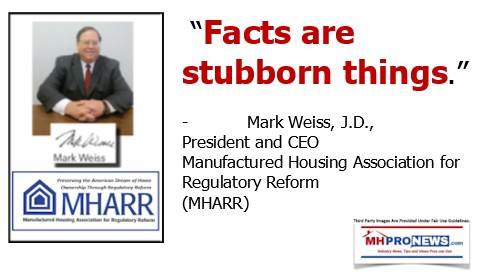
MHProNews Analysis and Commentary
In no specific order of importance, let’s first note that Brian Montgomery has been referred to by MHI as their candidate for the role he’s been nominated to hold. Yet, the history of Montgomery at HUD has been problematic for the industry, and he has purported conflicts of interest as the report below outlines.
Trump Administration Asked to Withdraw Brian D Montgomery Nomination Over Conflicts of Interest
For several reasons, not limited to those cited above, MHProNews has opposed the nomination of Montgomery to be the next Deputy Secretary of Housing and Urban Development (HUD).
Next, MHProNews has tracked years of problematic “advocacy” by MHI on regulatory issues, such as their notorious handling of proposed DOE energy standards. MHARR successfully stopped that effort, ultimately forcing through well-reasoned and sustained opposition to proposals that MHI initially supported. MHARR did so using the same type of carefully documented and sustained opposition that the document above exhibits.
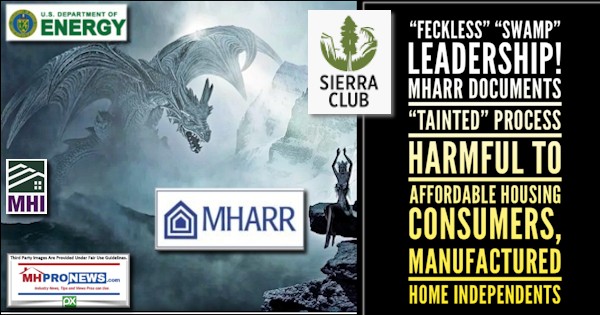
MHI has been largely silent on the above, but why? Is it because Warren Buffett-led Berkshire Hathaway is supporting some of the same nonprofits that are fighting against the interests of manufactured housing independents?
The problematic ways that nonprofits are performing are outlined by no less a person that Peter Buffett, Warren Buffett’s son. Buffett’s own son undercuts those surrogates of MHI, the Berkshire brands and their allies who want to cast concerns that MHI and their puppet masters are undermining the industry from within.
While manufactured housing may be a more severe case than other sectors of the economy, it is in other ways a microcosm of a pattern has been underway for decades. That pattern is enriching a few who widen their moats in a variety of ways, including using – or misusing – nonprofits like MHI.
The trauma that what the right-of-center Epoch Times is calling the CCP Virus – a.k.a. the Wuhan virus, China Virus, COVID19 or coronavirus – is a sobering time to evaluate precisely what has gone wrong in manufactured housing. While some MHI connected personalities purportedly stir the pot with trivialities, the industry faces a new crisis.
There have been steady and consistent defense of independent producers and those whom they work with by MHARR. By contrast, MHI strive to project an image of doing good for manufactured housing, while they are de facto failing to do what circumstances call for if they are sincere about advancing the industry’s interests. That’s highlighted by whistleblowers with apparent ties to MHI who documented the conflicts of interest between MHI’s new CEO Lesli Gooch and her lobbying on behalf of conventional housing.
It’s as Senators Bernie Sanders (VT-I and self-proclaimed Democratic Socialist), Elizabeth Warren (MA-D) and President Donald J. Trump have all said is a rigged system.
Returning post-COVID19 crisis to the status quo would not be a success, it would only foster more consolidation. Instead, what is needed is a revolt against the status quo. That should be done in part by supporting those like MHARR who have consistently for years fought for what’s needed for manufactured housing to advance from two decades of lethargy that accelerated since Buffett-led Berkshire acquired Clayton Homes, 21st Mortgage and other pieces of the industry.
To achieve the limelight that HUD Secretary Carson says is merited, only changing the status quo will work. That means exposing years of MHI’s failures and posturing. It also means that the rigged system that Peter Buffett in part explains must be addressed legally. Antitrust law is one step in that process, but not the only one.
To do anything but learn the lessons of years of “grotesque failure” requires understanding why MHI has feared MHARR for so long, and then support those that have exposed the corrupted and rigged system that has kept manufactured housing underperforming while it has steadily been consolidated at discounted valuations.
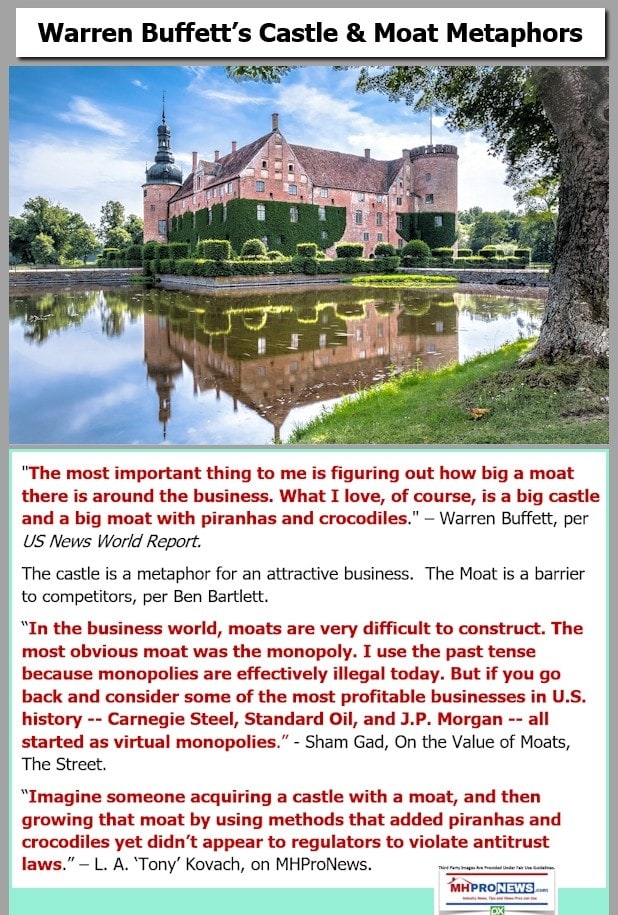
To learn more see the related reports below the byline and notices.

The industry has been underperforming for years. Why would it be so unless the powers that be wanted it that way, so they could consolidate more of the industry at a discounted valuation? The years of frutrating MHI results – are they accidental or intentional? Is it just a coindience that the industry is being consolidated by a relatively small group of MHI insider firms?

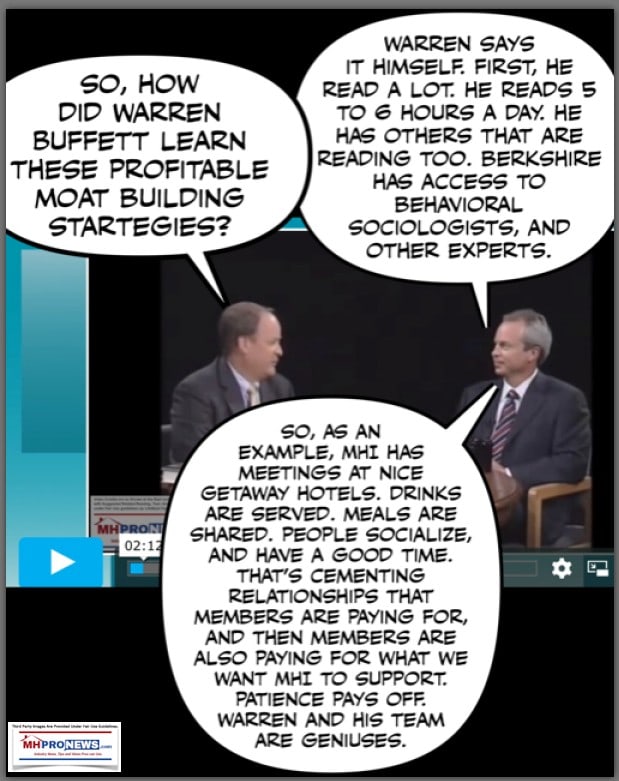
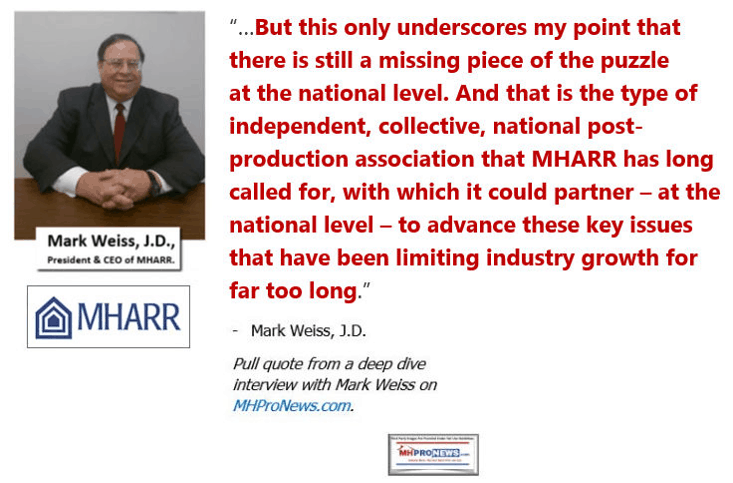
There are other Berkshire Hathaway, Clayton Homes, Bill Gates, and more manufactured home specific related developments that will be part of upcoming reports. But that’s a wrap on this installment of manufactured home “Industry News Tips and Views Pros Can Use” © where “We Provide, You Decide.” © (Affordable housing, manufactured homes, reports, fact-checks, analysis, and commentary. Third-party images or content are provided under fair use guidelines for media.) (See Related Reports, further below. Text/image boxes often are hot-linked to other reports that can be access by clicking on them.)

By L.A. “Tony” Kovach – for MHLivingNews.com.
Tony earned a journalism scholarship and earned numerous awards in history and in manufactured housing. For example, he earned the prestigious Lottinville Award in history from the University of Oklahoma, where he studied history and business management. He’s a managing member and co-founder of LifeStyle Factory Homes, LLC, the parent company to MHProNews, and MHLivingNews.com. This article reflects the LLC’s and/or the writer’s position, and may or may not reflect the views of sponsors or supporters.
Connect on LinkedIn: http://www.linkedin.com/in/latonykovach
Related References:
The text/image boxes below are linked to other reports, which can be accessed by clicking on them.
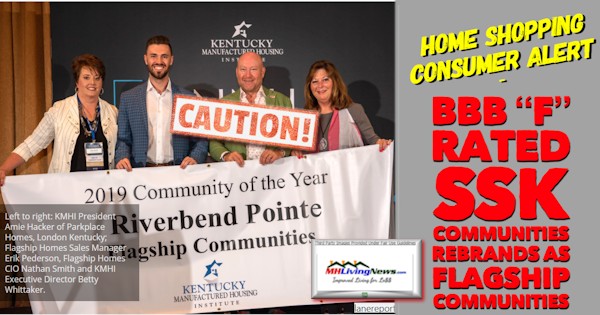
Are Manufactured Housing Supply Chains in China Threatened by Coronavirus?

